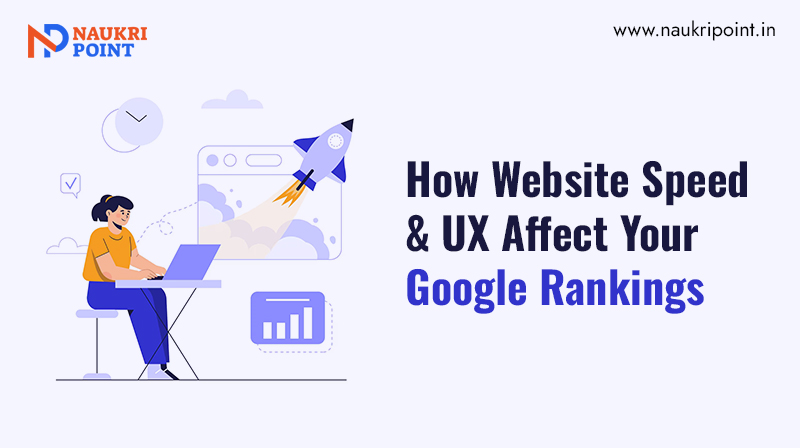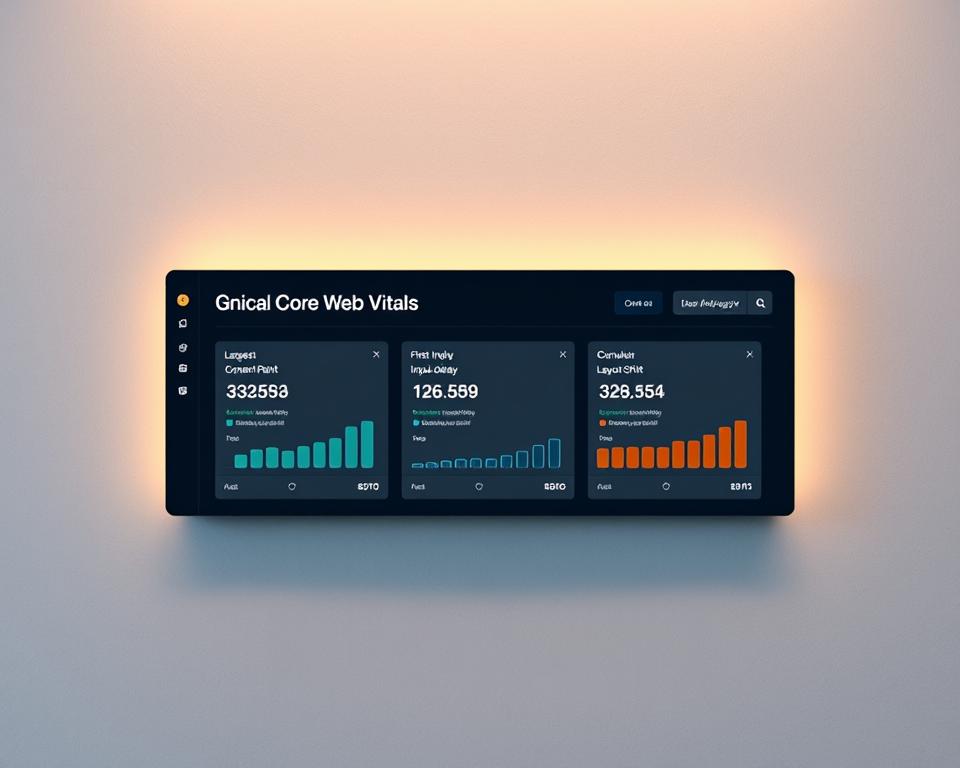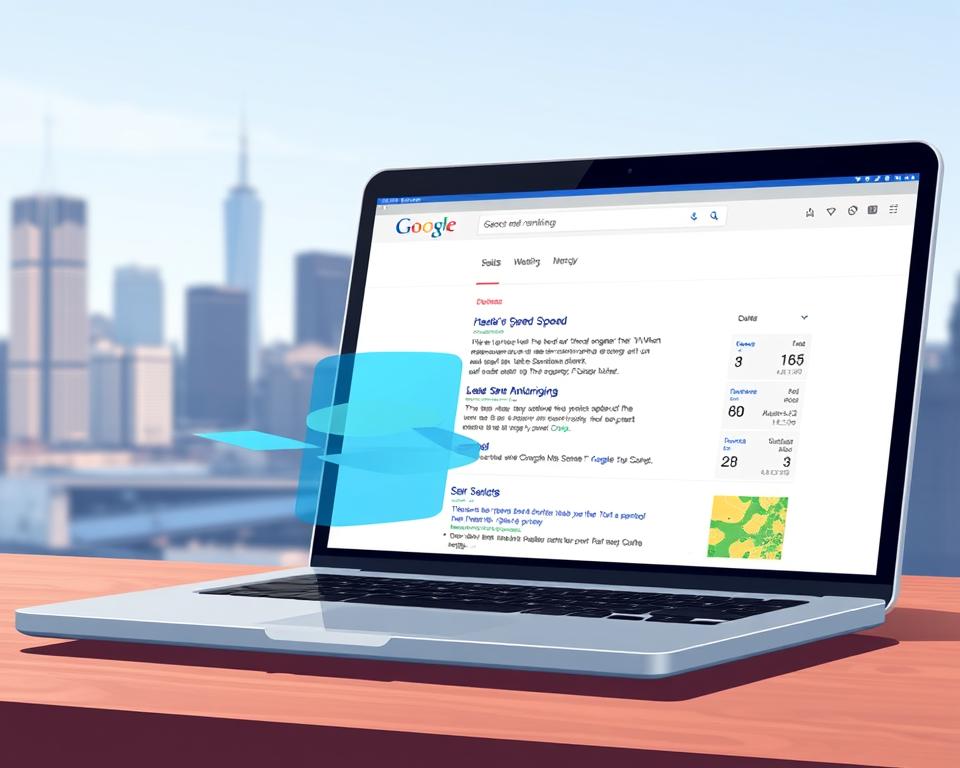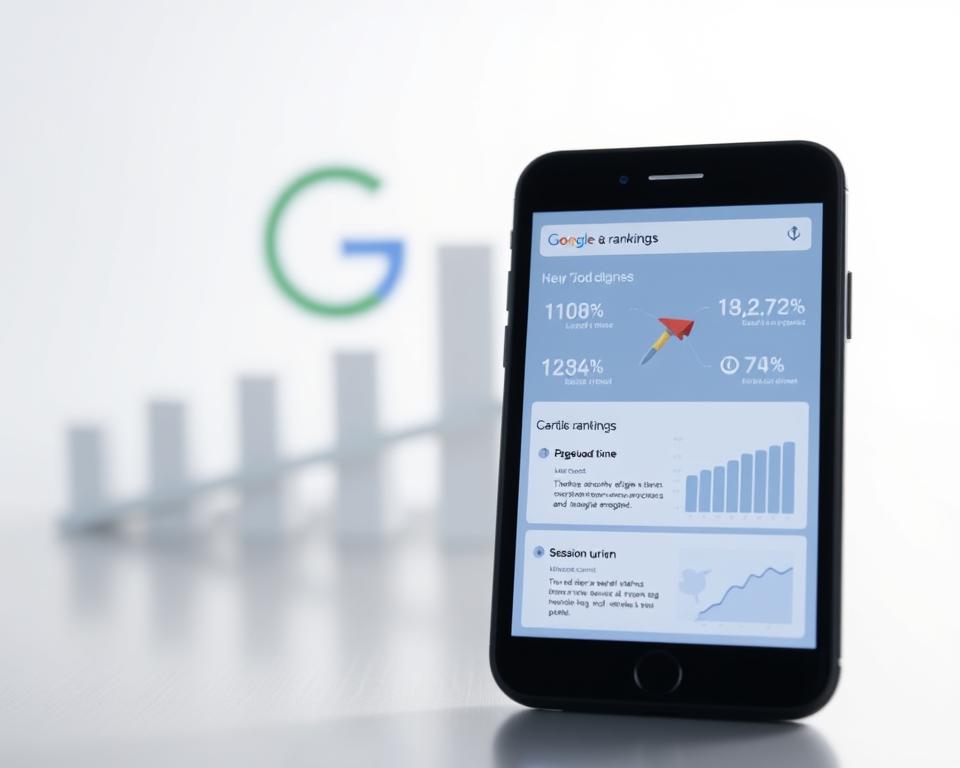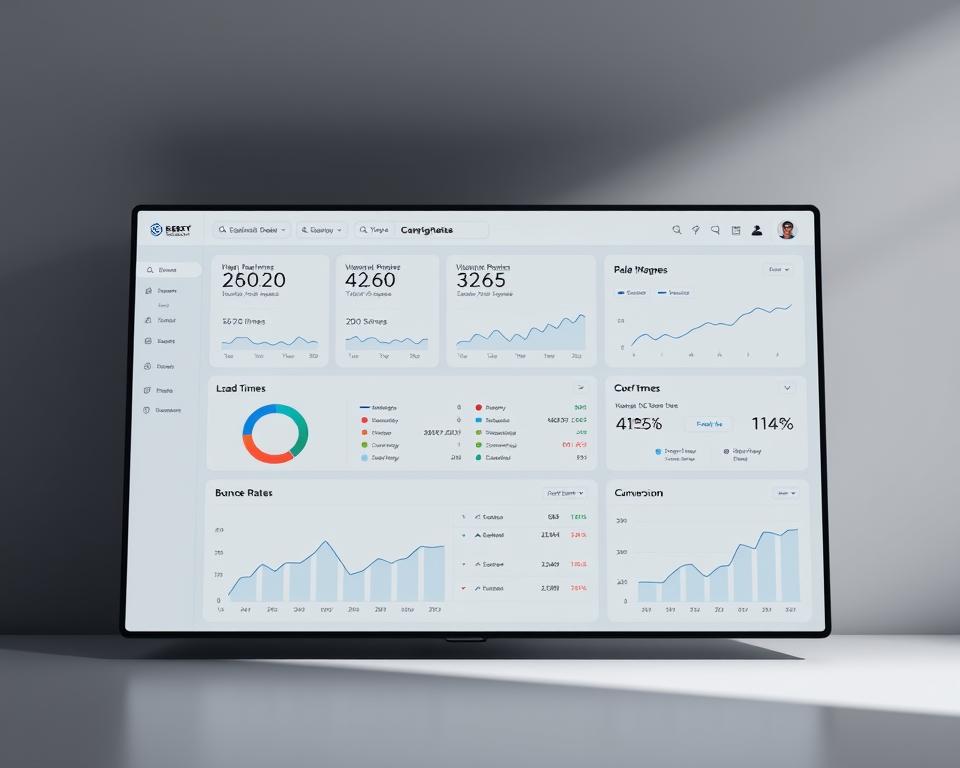In today’s digital world, having a fast and user-friendly website is key to success online. Google’s algorithms focus on user experience and website performance. These are important for ranking in search engines.
A slow or hard-to-use site can cause people to leave quickly. This can hurt your Google rankings. On the other hand, a site that loads fast and is easy to use can make users happier. It also boosts your chances of ranking higher in search results.
It’s important to understand how website speed, UX, and SEO work together. This knowledge is crucial for businesses wanting to improve their online presence.
Table of Contents
Key Takeaways
- Website speed and UX are critical factors in Google’s ranking algorithms.
- A fast and user-friendly site improves user satisfaction and engagement.
- Optimizing website performance is essential for SEO success.
- Slow websites can lead to higher bounce rates and lower rankings.
- Understanding the relationship between website speed, UX, and SEO is vital for online success.
The Evolution of Google’s Ranking Factors
Google’s ranking factors have changed a lot over time. This change shows how the search engine now looks at website quality differently. Google keeps updating its algorithms to give users the best search results.
From Keywords to User Experience
At first, Google’s algorithms were all about keywords and meta tags. But as the web grew, so did Google’s methods. Now, Google values user experience more, like page speed and mobile friendliness.
This change made SEO strategies more complex. Webmasters and content creators had to focus on more than just keywords.
The Introduction of Page Experience Signals
Google started focusing on Page Experience Signals too. These include page speed, how well a site works on mobile, and how stable the visuals are. These signals help make a website better for users.
By using these signals, Google wants to reward sites that are easy and fun to use. This shows how important SEO evolution is in keeping up with user needs and new tech.
Why Website Speed Has Become Critical for SEO
Website speed is now key in SEO, thanks to mobile-first indexing. Google values user experience, making website speed a ranking factor.
Mobile-First Indexing and Its Impact
Google now focuses on mobile versions of websites for indexing and ranking. A fast mobile site is essential for a good user experience. Slow websites can cause users to leave quickly, hurting SEO.
- Make sure your website works well on mobile and adjusts to screen sizes.
- Optimize images and use browser caching to speed up your site.
- Reduce the use of JavaScript and CSS that slow down your site.
The Correlation Between Speed and Bounce Rates
Website speed and bounce rates are linked. Fast sites keep users engaged, while slow sites lose them. Slow sites often see more users leave, telling search engines they’re not good.
Speed as a Competitive Advantage
In today’s online world, being fast can set you apart. Fast websites offer a better user experience and rank higher in search results. By speeding up your site, you can beat competitors and draw more visitors.
Understanding Core Web Vitals
Core Web Vitals are key to making your website better for users and search engines. They measure how well a webpage works and feels. This includes things that affect how users experience your site.
These metrics are part of Google’s page experience signals. They help decide how high your site ranks in search results. The three main metrics are Largest Contentful Paint (LCP), First Input Delay (FID), and Cumulative Layout Shift (CLS).
Largest Contentful Paint (LCP) Explained
Largest Contentful Paint (LCP) shows how long it takes for the biggest part of a page to show up. It’s important because it tells us when the main part of a page loads.
Optimal LCP Thresholds
To make sure users have a good experience, LCP should be under 2.5 seconds. You can get this by optimizing images, using browser caching, and reducing CSS.
First Input Delay (FID) and Interaction to Next Paint (INP)
First Input Delay (FID) measures how long it takes for a page to react after a user interacts. Interaction to Next Paint (INP) looks at the delay of all interactions during a user’s visit. It gives a fuller picture of how interactive a page is.
Measuring and Improving Interactivity
To better FID and INP, work on optimizing JavaScript execution. Also, reduce the effect of third-party scripts and make sure the main thread isn’t slowed down by heavy tasks.
Cumulative Layout Shift (CLS) and Visual Stability
Cumulative Layout Shift (CLS) checks how stable a page’s content is during loading. A lower CLS score means better stability.
To lower CLS, make sure all media elements have size attributes. Also, avoid adding content on top of existing elements. Use CSS transforms for animations instead of changing layout properties.
How Website Speed & UX Affect Your Google Rankings
The link between website speed, user experience (UX), and Google rankings is complex. As search engines grow, knowing this connection is key to better website performance.
Direct Ranking Impacts
Website speed directly impacts Google rankings. Google has said page speed is a ranking factor, especially for busy sites. A quick site can boost your search rankings, while a slow one can hide you from view.
Indirect Ranking Effects Through User Behavior
UX also affects rankings indirectly through how users act. A bad UX can cause more people to leave quickly, spend less time, and buy less. Google looks at these signs to judge your site’s value to users.
The Compounding Effect on SERP Positioning
The mix of direct and indirect effects greatly changes your site’s spot on search results pages (SERPs). By making your site faster and easier to use, you can get more visitors and grow your online presence.
A site that’s well-optimized not only ranks better but also gives users a great experience. This creates a cycle of improvement for your site’s performance.
The Business Impact of Slow-Loading Websites
A slow website can hurt your business a lot. It’s key to make your site fast. Today, people want quick access to info. A slow site can make them leave.
Conversion Rate Correlation with Page Speed
Page speed and conversion rates are linked. A one-second delay can cut conversions by 7%. This shows how important fast websites are for better user experience and more sales.
Here are some stats on page speed and conversions:
- A 1-second delay in page load time can result in a 7% reduction in conversions.
- A 3-second delay can lead to a 16% reduction in conversions.
- 40% of users will abandon a website that takes more than 3 seconds to load.
Revenue Loss from Poor User Experience
Slow websites can cost a lot of money. Frustrated users leave, leading to lost sales. In fact, slow sites can lose up to $2.6 billion in sales each year.
Revenue loss comes from many places, like:
- Lost sales because of frustration and leaving early.
- A bad reputation for your brand.
- Less customer loyalty.
Jeff Bezos of Amazon said, “We see our customers as invited guests to a party, and we are the hosts. It’s our job every day to make every important aspect of the customer experience a little bit better.” This shows why focusing on user experience is crucial to avoid losing money.
Technical Factors Affecting Website Speed
Many technical factors can change a website’s speed. Knowing these is key to making your site faster and better for users.
Server Response Time and Hosting Quality
Server response time is very important for website speed. It’s how fast the server answers a user’s request. A slow server can make pages load slowly, hurting the user’s experience.
Choosing a good hosting service can make your server faster. Reliable hosting providers help your site load quicker.
Image Optimization Techniques
Images are big on web pages and can slow them down. Making images smaller is key to a faster site. You can do this by compressing them, picking the right format, and resizing them correctly.
Next-Gen Formats and Lazy Loading
Using new image formats like WebP can make images smaller. Also, lazy loading loads images only when you see them. This makes pages load faster and feel better.
JavaScript and CSS Optimization
JavaScript and CSS files can slow down your site if not optimized. Making these files smaller can help them load faster. Also, splitting code can make your site load quicker by only loading what’s needed first.
Render-Blocking Resources
Resources like JavaScript and CSS can block pages from loading. It’s important to make these load faster. Deferring JavaScript and inlining critical CSS can help. This makes your site load faster and feel smoother.
UX Elements That Influence Rankings
A good UX is key for both users and Google rankings. Google checks a website’s UX to see if it’s useful and relevant.
Mobile Responsiveness
Most people use mobile devices to surf the web. Mobile responsiveness is very important. A site that works well on all devices gives a better experience. This can help your site rank higher in search results.
Intuitive Navigation and Site Structure
Intuitive navigation and a clear site structure help users find what they need fast. A well-organized site makes users happy and helps search engines index content better.
| UX Element | Impact on Rankings |
|---|---|
| Mobile Responsiveness | Improves user experience and search engine crawling |
| Intuitive Navigation | Enhances user satisfaction and facilitates content indexing |
| Content Accessibility | Increases readability and usability for all users |
Content Accessibility and Readability
It’s important for content to be easy to read and access. Use clear fonts, right font sizes, and good color contrast. Content accessibility helps everyone and boosts user engagement.
Interstitials and Pop-ups: Finding the Balance
Interstitials and pop-ups can grab attention but can also be annoying. It’s important to use them wisely. They should not block users from seeing content.
By improving UX, website owners can make their sites better for users and Google. This leads to higher rankings.
How to Measure Your Website’s Performance
Checking how well your website works is key to making it better. This means looking at how users feel and how search engines see it. To do this, you use special tools and methods.
There are many tools and ways to check your website’s performance. Google PageSpeed Insights, Lighthouse audits, and the Chrome User Experience Report are some of them. Each tool gives you different information about your website.
Google PageSpeed Insights
Google PageSpeed Insights is a top tool for checking website speed. It looks at how fast your site loads and suggests ways to make it better. This can help improve how users feel and might even help your site rank higher in search results.
Lighthouse Audits
Lighthouse audits give a full check-up of your website. They look at speed, accessibility, and if you’re following best practices. This tool gives detailed reports on speed, SEO, and user experience, helping you find what needs work.
Chrome User Experience Report
The Chrome User Experience Report shows how real users interact with your site. It looks at things like how fast pages load, how interactive they are, and how stable they look. This helps you see how your site performs from a user’s point of view.
Field Data vs. Lab Data
It’s important to know the difference between field data and lab data. Field data shows how users really interact with your site. Lab data is collected in a controlled setting. Both are useful, and using them together gives a full picture of your site’s performance.
By using these tools and understanding the data they give, you can learn a lot about your website. This knowledge helps you make smart choices to improve it.
Practical Strategies to Improve Website Speed
As online competition grows, making websites faster is key for businesses. A quick website boosts user experience and helps with search rankings. Here, we’ll look at ways to make websites load faster.
Implementing Content Delivery Networks (CDNs)
A Content Delivery Network (CDN) uses servers worldwide to serve web content. This cuts down the distance to your website, making it load quicker. Using a CDN can greatly reduce wait times and improve user experience.
Browser Caching and Compression
Browser caching stores often-used website parts in your browser. This means your website loads faster when you come back. Also, making files smaller helps data transfer, speeding up your website.
Minimizing HTTP Requests
Every part of a webpage, like images and scripts, needs an HTTP request. Fewer requests mean faster loading times. Ways to do this include combining files and removing unused elements.
Database Optimization for Dynamic Websites
For sites that change often, a fast database is essential. Making database queries faster and cleaning up data helps. A well-optimized database means your dynamic content loads quickly, making your site fast.
| Strategy | Description | Impact on Speed |
|---|---|---|
| CDN Implementation | Distributes content across multiple servers | High |
| Browser Caching | Stores resources locally in the user’s browser | Medium |
| Minimizing HTTP Requests | Reduces the number of requests for webpage elements | High |
| Database Optimization | Improves efficiency of database operations | Medium |
By using these methods, businesses can make their websites much faster. This improves user experience and search rankings.
Balancing Aesthetics and Performance
Web technologies keep changing, making it key to balance looks with speed. A site that looks good but is slow can lose users. On the other hand, a fast site that looks bad might not keep users. The goal is to find a sweet spot that meets both needs.
Designing with Speed in Mind
Designing for speed means choosing wisely about what affects load times. This includes making images smaller, using new image formats, and cutting down on big scripts. By thinking about speed early on, developers can make sites that look great and load quickly.
When to Prioritize UX Over Speed (and Vice Versa)
At times, UX should come first, like on e-commerce sites where a rich experience can boost sales. But for sites full of content, speed is more important to keep users. Knowing what your site is for and what users want is key to making this choice.
| Scenario | Prioritize UX | Prioritize Speed |
|---|---|---|
| E-commerce Site | High | Medium |
| Content Blog | Medium | High |
Progressive Enhancement Approaches
Progressive enhancement means adding features gradually. Start with a basic site that works for everyone, then add more for those with better tech. This way, everyone gets a good experience, and those with more can enjoy more.
Using progressive enhancement helps developers meet the need for a rich experience while keeping sites fast for all users.
Enhancing User Experience for Better Rankings
Creating a seamless user experience is key to improving your website’s ranking. A well-crafted UX not only enhances user engagement but also contributes to better search engine rankings.
Creating Clear Call-to-Actions
Clear and concise call-to-actions (CTAs) are crucial for guiding users through your website. Effective CTAs help in improving user engagement and conversion rates. To create effective CTAs, ensure they are:
- Visible and easily accessible
- Clearly worded to convey the intended action
- Strategically placed throughout the website
Improving Page Layout and Visual Hierarchy
A well-structured page layout and visual hierarchy are essential for a positive user experience. This involves organizing content in a way that is easy to navigate and understand. Key considerations include:
| Element | Description | Best Practice |
|---|---|---|
| Headings | Organize content with clear headings | Use H1, H2, H3 tags appropriately |
| Content Spacing | Ensure adequate spacing between elements | Use CSS to control margins and padding |
| Visual Elements | Use images, icons, and graphics to enhance UX | Optimize images for faster loading times |
Ensuring Cross-Device Compatibility
With the majority of users accessing websites through mobile devices, ensuring cross-device compatibility is vital. A responsive design adapts to different screen sizes and devices, providing a consistent user experience. Key strategies include:
- Using responsive web design techniques
- Testing on various devices and browsers
- Ensuring that content is easily accessible on smaller screens
Accessibility Considerations for Inclusive UX
Accessibility is a critical aspect of UX, ensuring that your website is usable by everyone, including individuals with disabilities. Implementing accessibility features not only enhances user experience but also improves your website’s overall ranking. Considerations include:
- Following Web Content Accessibility Guidelines (WCAG)
- Using alt text for images and descriptive link text
- Ensuring that the website is navigable using keyboard controls
By focusing on these key areas, you can significantly enhance your website’s user experience. This leads to improved engagement, conversion rates, and ultimately, better search engine rankings.
Case Studies: Speed and UX Optimization Success Stories
Website speed and UX greatly affect Google rankings, as shown in many case studies. These examples help us see how different websites face challenges and find solutions. This way, we learn how to improve our online presence.
E-commerce Site Speed Improvements
An e-commerce site for outdoor gear boosted sales by speeding up their website. They used a content delivery network (CDN) and optimized images. This cut their page load time by 30%.
With faster loading, they saw a 25% jump in sales and a drop in bounce rates. This shows how important website speed is for e-commerce sites.
| Metric | Before Optimization | After Optimization |
|---|---|---|
| Page Load Time | 4.2 seconds | 2.9 seconds |
| Conversion Rate | 2.5% | 3.1% |
| Bounce Rate | 55% | 45% |
Content Site UX Redesign Results
A tech news site improved its UX to engage users more. They made navigation easier, content more readable, and the site mobile-friendly. This led to a 40% rise in user engagement, like time spent on the site and pages visited.
Local Business Website Optimization
A local home renovation service optimized their website for speed and UX. They minified files, used browser caching, and made the site mobile-friendly. This resulted in a 20% increase in organic traffic and better Google rankings for key terms.
These stories show that improving website speed and UX can greatly enhance search rankings and user engagement. This is true for all kinds of websites.
Common Speed and UX Mistakes to Avoid
To make your website fast and easy to use, you must avoid common mistakes. These errors can slow down your site and make it less appealing. Knowing these mistakes helps your site stand out online.
Overloading with Plugins and Scripts
Using too many plugins and scripts is a big mistake. They can make your site work better, but too many slow it down. It’s important to check and remove any plugins or scripts you don’t need.
Neglecting Mobile Optimization
Most people use their phones to browse the web. So, ignoring mobile optimization is a big error. Your site needs to work well on all devices. This means it should look good and be easy to use on phones and tablets.
Ignoring Web Accessibility Standards
Not following web accessibility standards is a big mistake. It can hurt your site’s visibility and even break the law. Making sure your site follows Web Content Accessibility Guidelines (WCAG) helps everyone use it better. It also makes your site more usable for everyone.
Conclusion
Website speed and UX are key to good Google rankings. Understanding Google’s ranking factors and Core Web Vitals is a good start. This helps businesses improve their online presence.
SEO should focus on both technical optimization and UX design. This means optimizing images and using browser caching. It also means making sure your site works well on mobile and has clear calls-to-action.
By using these strategies and avoiding common mistakes, businesses can boost their site’s speed and user experience. This leads to better Google rankings and more online success. For more tips, check out Google’s SEO best practices.







